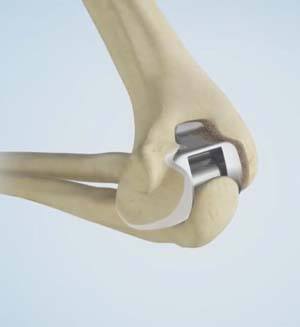Total Elbow Replacement

What is it?
Total elbow arthroplasty (replacement) is a surgical treatment for end-stage arthritis of the elbow joint. When the cartilage in your joint is worn out, this can lead to pain and stiffness in the elbow which can severely limit function. The most common indications for an elbow replacement are rheumatoid arthritis and post-traumatic arthritis. Sometimes, an elbow replacement is also indicated for patients with severe elbow fractures. During an elbow replacement, the arthritic surfaces of the elbow joint are replaced by a semi-constrained mechanical hinge. This improves elbow motion and eliminates the pain associated with arthritis.
How is it performed?
A total elbow replacement is performed through an incision on the back of the elbow. I prefer to leave the triceps attached to the bone when exposing the elbow joint since detachment of the triceps can lead to post-operative complications. The arthritic surfaces of the joint are removed. One end of the replacement is cemented into the distal humerus (arm bone), and the other end is cemented into the ulna (one of the forearm bones). A mechanical hinge is secured into place recreating the functional elbow joint.
This procedure is typically performed with a light general anesthetic along with a nerve block which numbs the arm giving the patient greater comfort in the immediate post-op period
What are the risks?
Major medical complications are rare during the peri-operative period of a total elbow. We screen patients carefully to ensure that they are at minimal risk for any of these complications. Aside from routine surgical and anethestic risks (bleeding, anesthesia side effects...), below are some of the most common risks associated with an elbow replacement:
Infection: Unlike most of the other joints replaced in the body, there is relatively little soft tissue between your skin and the elbow implant. This makes any wound issues more prone to seed the joint with infection.
Triceps Failure: Rupture of the triceps can lead to inability to activly extend the elbow. The risk is minimized by not detaching the triceps to expose the joint. This is our preference to prevent this complication from occuring.
Nerve Injury: In particular, one nerve (the ulnar nerve), which controls some of the muscles and sensation in your hand, is in the operative field. It must be identified and protected in every case. Other nerves can also be at risk too, but are further from the operative field. Injuries are not common, but when they do occur, it is usually related to stretching of the nerve, the majority of which recover with time.
Implant wear and loosening: The implant can wear over time, just like the tread on your car tires. This can potentially lead to loosening of the components. This takes many years to develop in most people.
How do I know if I have elbow arthritis?
Patients with end-stage arthritis of the elbow had pain with elbow motion. There is often a significant restriction in the range of motion of the elbow. This can make it difficult to perform simple tasks such as feeding yourself or washing your hair.
X-rays and examination are often all that is needed to diagnose you with elbow arthritis. Sometimes, advanced imaging such as CT scans or MRIs may be needed.
What are the expected results
In general, total elbow arthroplasty is excellent at relieving the pain associated with elbow arthritis and improving the motion of the elbow. Many patients are able to return to activities such as gardening, fishing, and performing day to day activities without pain. Some activities are discouraged including heavy manual labor, heavy repetitive lifting, or repetitive high impact activities. It is best to avoid lifting more than 10 pounds with the elbow since the implant is not built to withstand repetitive stress over time. While an elbow replacement will not give you a normal joint, it can go a long way towards improving the quality of life for patients afflicted with elbow arthritis.
How long is the recovery?
Patients typically stay in the hospital 1-2 nights. Many patients are off of all pain medications by their first post-operative appointment. The early recovery (<6 weeks) is focused on regaining elbow motion and protecting the triceps if it was detached (we prefer not to detach it). The middle of the recovery (6-12 weeks) is focused on regaining elbow strength and maintaining motion. The end of the recovery (>12 weeks) is focused on functional strengthening to get you back to the activities you desire. After 12 weeks there are no specific restrictions on the elbow but it is generally advised that patients should not lift more than 10 lbs for most activities.
Who is not a good candidate for a total elbow?
While a total elbow arthroplasty general provide predictably good results following surgery, there are some patients in which the results of a total elbow are less predictable. These include the following types of patients:
- Patients on chronic pain medications
- Patients with multiple prior surgeries on their elbow
- Patients with excessive bone loss at the elbow
- Patients who wish to perform repetitive heavy lifting
- Patients in poor general health and physical conditioning
While having any of these conditions does not mean that a total elbow arthroplasty cannot be performed, it could mean that alternative methods of treatment may be safer and more predictable.







